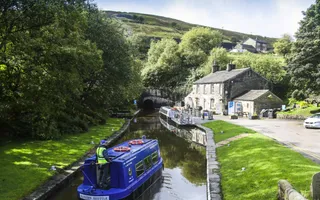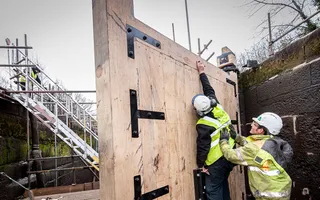Crossing the rugged Pennines, this route takes in the Calder & Hebble, the Huddersfield Broad and Narrow Canals and the Ashton Canal before returning via the Rochdale.
The breathtaking scenery on the journey is made even more remarkable as until recently much of the route was derelict. From Sowerby Bridge Basin the Calder & Hebble Navigation heads eastwards. Various improvements have given it the appearance more of a canal than a river but it is prone to changes in water levels so check our stoppages pages before you set off. Flood defences along the route minimise this by preventing high water levels entering the artificial channels. Short branches and old basins make for interesting diversions.
Note: You'll need a handspike to work the locks on the Calder & Hebble instead of the more usual windlass. A long-distance footpath connects with the towpath near Brighouse.
Pennine climb
At Cooper Bridge Junction the Huddersfield Broad Canal, or Sir John Ramsden’s Canal, leaves the Calder & Hebble and continues for some three and a half miles to link with the Huddersfield Narrow Canal at Aspley Basin in the centre of Huddersfield before the route begins its long climb up the imposing Pennines. Restoration of the Huddersfield Narrow Canal, which has been dubbed ‘The River of Gold’. Since being reopened in May 2001, it's proved to be a catalyst for widespread regeneration. Reclamation efforts at, for example, Slaithwaite where the canal had been totally lost, are impressive.
Navigating Standedge
This ring takes boaters through the longest, deepest, highest tunnel in the UK - Standedge. Check our guidelines for booking your passage and preparing for the journey.
Locks on the Huddersfield Narrow Canal are denoted by E and W on the east and west side of the Pennines. Dropping down the west side of the hills to Dukinfield Junction the Huddersfield Narrow meets the Ashton Canal, a waterway much enhanced by developments following the Commonwealth Games of 2002 held in Manchester.
Rochdale restoration
Ducie Street Junction in Manchester sees the Ashton Canal meeting the Rochdale Canal and a journey of 32 miles back across the Pennines to Sowerby Bridge.
Restoration of the Rochdale Canal began in earnest in the 1980s and it was reopened throughout in 2002. Reservoirs around the summit level are a consequence of a large number of locks on a relatively short length of canal. The deep lock at Tuel Lane near Sowerby Bridge (said to be the deepest on our waterways) replaces two earlier locks that were lost to road development and is an imposing 19 feet (5.8m) deep.







